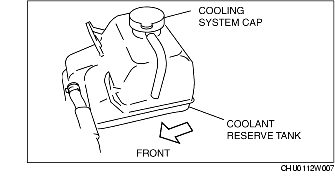ENGINE COOLANT REPLACEMENT
BHE011215001W04
-
Warning
-
• Remove and install all parts when the engine is cold, otherwise they can cause severe burns or serious injury.
-
• Turn off the engine and wait until it is cool. Even then, be very careful when removing the cap. Wrap a thick cloth around it and slowly turn it counterclockwise to the first stop. Step back while the pressure escapes.
-
• When you are sure all the pressure is gone, press down on the cap using the cloth, turn it, and remove it.
-
Caution
-
• Use engine coolant at a concentration that meets the environmental conditions in which the vehicle is driven, otherwise engine damage could occur.
-
• The engine has aluminum parts that can be damaged by alcohol or methanol antifreeze. Do not use alcohol or methanol in the cooling system. Use only ethylene-glycol-based coolant.
-
• Use only soft (demineralized) water in the coolant mixture. Water that contains minerals will reduce the coolant's effectiveness.
-
• Engine coolant damages paint. If engine coolant does get on a painted surface, rinse it off quickly.
1. Remove the cooling system cap.
2. Loosen the radiator drain plug and drain the engine coolant.
3. After completely draining the engine coolant, tighten the radiator drain plug.
4. Add engine coolant into the coolant reserve tank up to the F mark.
5. Install the cooling system cap.
6. Start the engine and warm it up by idling.
-
Caution
-
• If the water temperature gauge rises too high, stop the engine and decrease the water temperature to prevent overheating.
7. After the engine warms up, perform the following steps.
-
(1) Run the engine at approx. 2,500 rpm for 5 min.
-
(2) Run the engine at approx. 3,000 rpm for 5 min, then return to idling. Repeat this procedure several times.
8. Stop the engine, wait until it is cool, and check the engine coolant level. If the engine coolant decreases, repeat Steps 4-8.
9. Inspect each area for engine coolant leakage.
